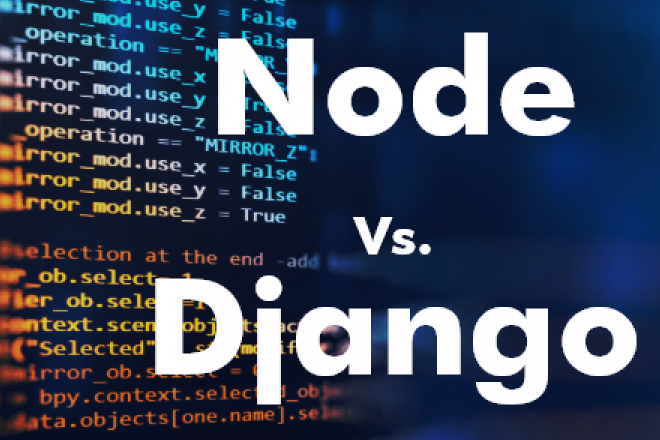Django and NodeJs are two powerful technologies that fulfill modern web app creation demands for rich features and adaptability. All are open-source and can be downloaded for free without the need for a license. Any beginner web developers are perplexed when determining which of these solutions to use in their workflow because they are both similarly common and progressive.
Both programming languages are open source and have a vast web development community that actively improves them. While both languages have the best functionality, many developers are frustrated with deciding which one to choose for a workflow.
Django vs. NodeJS
To put it another way, NodeJs is used on the client-side of applications based on JavaScript. On the other hand, Django is a Python programming platform that developers use all over the world to deliver real-time Python software. Even though both languages are flexible in their ways, this article would compare and contrast the two. An application will run smoothly on a platform if the underlying platform can support all of its features. The application’s specifications determine which platform is best for it.
Django
Django is an open-source Python web platform with a lot of features. It’s most often used to build technical websites and web apps from an official site. Django is a high-level programming language in which the bulk of the coding has been abstracted away to allow for clean and functional code writing.
NodeJS
NodeJS is a JavaScript runtime environment written in C, C++, and JavaScript that is open-source. It’s used to build server-side JavaScript-based high-level network applications. With JavaScript, developers can create complete and highly scalable web applications.
Django vs. NodeJs: The basics
Let’s start at the very beginning. It’s difficult to equate Django and NodeJs in certain respects because they’re entirely different. Django is a high-level Python platform developed for rapid growth and scalability, according to our Python/Django developers. It bills itself as “the web development for perfectionists with deadlines.” It’s free and open-source. It operates similarly to other programming projects in that it provides pre-built modules, libraries, and software to remove the need to code anything from the ground up.
Instead of becoming a development platform, NodeJs is a runtime environment that allows developers to run frontend JavaScript code on an official site as a backend programming language. Although you can use third-party libraries, there is no substitute for the ready-made components that Django frameworks have – it’s just essential, no-nonsense JavaScript coding.
The specifics
Although both Django and NodeJs are excellent backend frameworks, their distinct characteristics mean that one could be better suited to your project than the other.
The architecture
Django uses a Model View Template to run (MVT). This is analogous to the Model Display Controller architecture (MVC), which separates the code into three functions (‘set’ – data or code for different app elements, ‘monitor’ – code that regulates how users see and communicate with your app, and ‘controller’ – code that controls the interface between the two). Django is a battery-powered system that requires adhering to its ideology and structure. Heavy customization can be complicated because it necessitates delving into internal code.
NodeJs is based on event-driven programming, and it uses frontend JavaScript for backend creation. Backend modules can communicate with the operating system, external APIs, file I/O, databases, and other systems. This helps you write backend code using the NodeJs runtime while keeping the frontend in the same JavaScript language. This ensures the static code can be shared between the backend and the frontend. NodeJs is not a module, as previously said. Packages in NodeJs are primarily small and modular. NodeJs also has a well-known package management problem.
Security
Python is one of the most stable programming languages available, thanks to its well-defined task execution approach, robust security-based libraries, and scalability. This makes it easier to write code without introducing technical flaws that hackers can exploit or develop new ones as you grow. Because of the language’s architecture, JavaScript is more prone to errors. While JavaScript can build stable applications, its layout makes it far easier to overlook possible flaws than Python. If you’re using NodeJs to create your software, it’ll be vulnerable to this flaw, so be cautious about third-party add-ons and keep an eye out for malicious code snippets.
Performance speed
The success of NodeJs is excellent, but the JavaScript caveats limit it. Due to the simplicity of its event loop, JavaScript is too slow for computation-heavy applications, and the lack of support for decimals further restricts its use. Django is swift, despite Python’s Global Interpreter Lock, and Python is great for large-scale data analysis and calculation. Overall, whether the web development depends on something that JavaScript struggles with, it’s a tie. To solve single-threaded runtime, both NodeJs and Django will benefit from multi-process approaches.
Development speed
Django takes a code-light approach to software production as a platform. This ensures that there are many pre-built plugins for various functions that developers can use instead of having to code anything from scratch. It is built on Python, a relatively simple programming language, which results in a brilliantly fast time-to-market. In 2008, Bitbucket was released on Django in less than a month. We’re ready to gamble if Django comes out on top. There’s a case to be made that combining NodeJs into the frontend saves time because you’re only dealing with one scripting language, but even taking this into account, we recommend against it.
Adaptability
If you don’t need to evolve quickly and want more time to experiment with your thoughts, NodeJs is the best choice. This is because Django is:
- A code-light architecture based on a set of pre-built modules.
- Python is used, and it has a reputation for ‘forcing’ you to write items in specific ways.
These are undeniably some of Django’s strengths in web development speed, but they can hinder the developers’ creativity. No-frills JavaScript architecture isn’t the quickest way to go, but it’s undoubtedly the right choice if you’re more concerned about coding versatility.
Expense
This is a win for NodeJs, but it’s not a huge one. JavaScript wages are typically a little less than Python salaries, but the genuine cost savings come from not employing a separate team of frontend developers. If your backend is designed with Django, you will need to recruit more developers to create your app’s frontend if your Python developers don’t have the required skills. Everything you need for NodeJs is JavaScript; there’s no need for extra pairs of hands.
Competence
This is one of the most important things to remember when determining between Django and NodeJs. According to others, most major programming languages can be scaled with the right time, budget, and production expertise. Yet, this is time, resources, and developer talent that could be put to better use, and there are few things more challenging than seeing the app slowed down by scalability problems right as it’s taking off.
As a python app manager, Django is usually used with gunicorn or uWSGI. This can be used in combination with NGINX, a popular web server. Gunicorn, uWSGI, and NGINX all provide a variety of network I/O scaling configurations. Multi-process approaches to spawning more Django software instances are also available in Gunicorn and uWSGI.
NodeJs takes a similar approach to Django mentioned earlier. It can either spawn more processes or add more RAM to handle concurrent requests by the event loop.
What’s the verdict? This is a tie. You’ll need developers that know how to write safe, reliable code and customize it for either to scale properly. However, neither Django nor NodeJs has any inherent limitations. Here are some general rules to follow when choosing between your backend build options to break it down.
Django is the better option if
- You need to build your app quickly – Django’s code-light approach is ideal for this
- You’re looking for encryption that’s integrated straight into the code structure.
- You believe you will eventually incorporate emerging developments such as machine learning.
NodeJs is the better option if
- you value consistency and ingenuity over speed in the development process.
- You want the app to run as quickly as possible, but it’s not CPU supported.
- Your frontend is written in JavaScript, and you want to take advantage of the cost and productivity benefits that come with it.
- Your frontend is written in JavaScript, and you want to save money and increase productivity by having everybody use the same language.
Conclusion
There isn’t a clear winner between Django and NodeJs when it comes to developing flexible and stable web applications; there isn’t a clear winner between Django and NodeJs. Both languages have benefits and drawbacks, and there is no one-size-fits-all solution to determining which one to use. When deciding between the two technologies, developers must keep in mind the application’s specifications and go with their personal choice. Building a real-time framework with NodeJs is easy, although integrating more stable functions with Django is more complicated.












+ There are no comments
Add yours